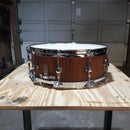Introduction: Passive Acoustic Speaker for Kindle Fire / Ipad
This is not a new idea, just my version of a diy on this passive acoustic speaker (PAS) for Kindle Fire or other mobile device with built in speakers. I was so stoked to get on this project that I did not take real-time step-by-step pictures of the process. Rather, I will show pictures of the finished PAS as I describe the construction process.
My goal was to have an attractive, portable, and functional form of acoustic amplification for my Kindle Fire. The result was a decorative piece that fits in with our design and offered a more detailed and dynamic sound for our listening pleasure. Enjoy!
My goal was to have an attractive, portable, and functional form of acoustic amplification for my Kindle Fire. The result was a decorative piece that fits in with our design and offered a more detailed and dynamic sound for our listening pleasure. Enjoy!
Step 1:
The first step was to select a piece of walnut wood with the dimensions of 5 1/4 " x 5 1/4 " x 1 3/4" thick. I chose walnut because of it's density and reflective qualities when it comes to sound reproduction. I also like the look of the grain and figure.
Step 2:
The next step was to rout the bottom of the PAS to a depth of 5/16". I left a 3/4" wide swath on the front and back edge to be used as the legs of the speaker.
Step 3:
Step 3 was the routing of the Kindle Fire channel in the top of the PAS. I made this slightly wider than the mobile device and routed to a depth of 9/16", just deep enough for solid support of the Kindle Fire. After that I drilled holes in the channel through the base of the PAS to line up with the speakers on the device. I then gouged the holes into a rectangular port to fit the dimension of the built in speakers.
Step 4:
Next I added ports on the two sides of the PAS. This was done by routing a 2" wide x 1" deep channel positioned near the front of the PAS. The next step was to create a sound path between each side port and it's respective speaker port. I did this by drilling a diagonal hole with a 3/8" bit between the two ports. The sound path intersected the top speaker port just below where the Kindle Fire rests in the top channel.
Step 5:
I sanded all the surfaces and the inside of the channels to smooth. This is done using the "raising the grain" process of sanding, lightly dampening the surface, letting it dry and then sand again. Repeat using gradually finer grade sandpaper and you will have a "baby butt smooth" piece when you are done. I finished the PAS with Howard Restor-A-Finish to bring out the natural beauty of the walnut and not diminish the reflective sound quality of the wood. Lastly, I added some green felt feet to the legs to reduce any vibration or potential scratching of the underlying surface.
Step 6:
This was my first attempt at producing a passive acoustic speaker to be used with a mobile device. Certainly different tones and equalization of the sound could be achieved by using different dimensions of wood and position of the ports / depth of the bottom routing. The sound will also be inter- dependent on the reflecting surface upon which the PAS rests. Our oak coffee table differs from the Equatorial wood of the bar (in the pictures) and both produce a different tone than the kitchen granite counter top. I will be looking for YOUR version of the passive acoustic speaker on the "ible" soon!
Click on this link for a demonstration of the PAS:
http://www.youtube.com/watch?v=HTq53eTBAVc&feature=youtu.be
Click on this link for a demonstration of the PAS:
http://www.youtube.com/watch?v=HTq53eTBAVc&feature=youtu.be

Participated in the
Indestructibles Contest











